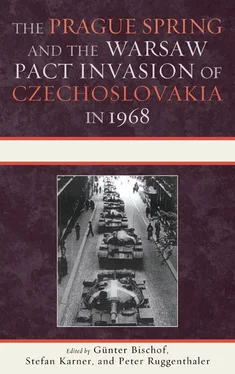The president and his advisors soon were disabused of that notion. At 11:00 p.m. on 20 August, a Soviet Spetznz battalion landed at and occupied Prague airport. 57At 11:11 p.m., NATO radar monitors reported that the air space around Prague was covered with artificial “snow,” blanking out radar screens and preventing observation of what was happening. 58Just a few hours later, at 2200, Washington, DC, time, Helms was summoned back to the White House for an emergency meeting. The invasion of Czechoslovakia was underway. 59
Given the swiftness of events, it is hard to see how Johnson could have received more warning than he did. Official Washington was holding its breath in August 1968, waiting to see what the Soviets would do. Ample, precise, and accurate strategic warnings concerning events in Central Europe had been pouring in all summer. The August calm before the storm may have meant that much of the intelligence community was surprised by the invasion when it occurred, but there had been no indication that the Soviets had stood down in Central Europe, nor had strategic warnings ever been withdrawn.
A CIA memorandum prepared immediately after the event noted that the decision to intervene must have come very late in the game. 60Exactly how and when Moscow’s forbearance “became unraveled” was something of a mystery. To CIA analysts, however, it was clear that the decision had come some time after the Čierná nad Tisou and Bratislava conferences. The time that elapsed, the scattering of the Soviet leadership to their dachas for the August holidays, the attitude of the Soviet press, and the anodyne communiqués that were issued after each meeting all were indicators that the Dubček government was being given more time—to do what was not clear. 61“The most likely explanation,” Agency analysts concluded, “appears to be that, under the impact of internal pressures within the leadership and of importuning from its anxious allies in Eastern Europe… the fragile balance in the Soviet leadership which produced the Čierná agreement has, in the space of less than three weeks, been upset in favor of those who may all along have wanted the toughest kind of policy….” With the political scales in Moscow in such precarious balance, “it would not have needed a great shock to upset them.” 62
So, on the morning of 21 August, Czechoslovakia was invaded from the north, east, and south by twenty Warsaw Pact divisions totaling some 250,000 men. At the same time, the positions vacated by these units were backfilled by ten Soviet divisions. Once strategic points in Czechoslovakia were occupied, most of these forces redeployed into western Czechoslovakia, restoring the front against NATO. 63There they were backed by the full might of the Warsaw Pact, including thousands of nuclear weapons targeted against Western and Central Europe. Nothing short of a world war was likely to get them out. In 1938, the Western powers had responded to threats against Czechoslovakia by backing down, rather than face a Nazi Germany they falsely believed was ready for war. In 1968, they had no choice.
1. All statements of fact, opinion, or analysis expressed are those of the author and do not reflect the official positions or views of the Central Intelligence Agency (CIA) or any other U.S. government agency. Nothing in the contents should be construed as asserting or implying U.S. government authentication of information or CIA endorsement of the author’s views. This material has been reviewed by the CIA to prevent the disclosure of classified information.
2. Christopher Andrew and Vasili Mitrokhin, The Sword and the Shield: The Mitrokhin Archive and the Secret History of the KGB (New York: Basic Books, 1999), 250.
3. NIE 12-65, “Eastern Europe and the Warsaw Pact,” 26 August 1965, Doc. Nr. 273191, 1, 3–4. This and all other CIA primary source documents cited herein are available online from the CIA Freedom of Information Act Electronic Reading Room , http://www.foia.cia.gov(accessed 14 September 2008).
4. NIE 12-65, “Eastern Europe and the Warsaw Pact,” 5.
5. ONE Special Memorandum 10-65, “Prospects for Independence in Eastern Europe,” 18 February 1965, Doc. Nr. 427965, 1.
6. NIE Special Memorandum 1-68, “Czechoslovakia: A New Direction,” 12 January 1968; Doc. Nr. 608720, 14; CIA intelligence information cable, “Political Events and Personnel Changes in Czechoslovakia,” 27 March 1968, Doc. Nr. 242352, 7; unsigned CIA memorandum, 8 April 1968, Doc. Nr. 119580, 1–2.
7. Office of Strategic Research (OSR) intelligence memorandum, “Warsaw Pact War Plan for Central Region of Europe,” 18 June 1968, Doc. Nr. 969832, 5.
8. OSR intelligence memorandum, “Warsaw Pact War Plan,” 1.
9. OSR intelligence memorandum, “Warsaw Pact War Plan,” 1.
10. ER IM 68-33, “Economic Pressure for Change in Eastern Europe,” (27) March 1968, Doc. Nr. 427962, 2.
11. ER IM 68-33, “Economic Pressure for Change in Eastern Europe,” 1, 4.
12. Unsigned CIA memorandum, 8 April 1968, Doc. Nr. 119580, 1–2.
13. CIA intelligence information cable, “Political Events and Personnel Changes in Czechoslovakia,” 27 March 1968, Doc. Nr. 242352, 7–8.
14. CIA intelligence information cable, “Political Events and Personnel Changes in Czechoslovakia,” 7–8.
15. CIA, “Weekly Summary,” 19 April 1968, Doc. Nr. 44603, 13.
16. DI Intelligence Memorandum 0658/68 (OCI), “Czechoslovakia in Transition,” 23 April 1968, Doc. Nr. 608719, 2.
17. Unsigned CIA memorandum, 8 April 1968, Doc. Nr. 119580, 1.
18. ONE memorandum for the director, “Subject: The Czechoslovak Crisis,” 17 July 1968, Doc. Nr. 242346, 5.
19. Unsigned CIA memorandum, “Subject: The Czechoslovak Situation (as of 1200 hours),” 9 May 1968, Doc. Nr. 262105, 3; ONE Special Memorandum 12-68, “Subject: Czechoslovakia: the Dubček Pause,” 13 June 1968, Doc. Nr. 95035, 1.
20. CIA intelligence information cable, “Present USSR Attitudes toward Czechoslovakia,” 10 May 1968, Doc. Nr. 242350, 2.
21. For example, Jiri Valenta, Soviet Intervention in Czechoslovakia, 1968: Anatomy of a Decision (Baltimore: Johns Hopkins University Press, 1991).
22. Andrew and Mitrokhin, Sword and Shield , 250–57.
23. DI Intelligence Memorandum 0658/68 (OCI), “Czechoslovakia in Transition,” 23 April 1968, Doc. Nr. 608719, 12.
24. ONE Special Memorandum 12-68, “Subject: Czechoslovakia: the Dubček Pause,” 13 June 1968, Doc. Nr. 95035, 1.
25. ONE Special Memorandum 12-68, “Subject: Czechoslovakia: the Dubček Pause,” 16–18.
26. ONE Special Memorandum 12-68, “Subject: Czechoslovakia: the Dubček Pause,” 4.
27. ONE Special Memorandum 12-68, “Subject: Czechoslovakia: the Dubček Pause,” 5, 9.
28. ONE memorandum for the director, “Subject: The Czechoslovak Crisis,” 17 July 1968, 7.
29. ONE memorandum for the director, “Subject: The Czechoslovak Crisis,” 4.
30. ONE memorandum for the director, “Subject: The Czechoslovak Crisis,” 6–7.
31. ONE memorandum for the director, “Subject: The Czechoslovak Crisis,” 5.
32. ONE memorandum for the director, “Subject: The Czechoslovak Crisis,” 6.
33. CIA intelligence memorandum, “The Situation in Czechoslovakia as of 4:00 PM EDT,” 30 July 1968, Doc. Nr. 265449, 1.
34. CIA intelligence memorandum, “The Situation in Czechoslovakia as of 4:00 PM EDT,” 2.
35. James Bamford, Body of Secrets: Anatomy of the Ultra-Secret National Security Agency, from the Cold War to the Dawn of a New Century (New York: Random House, 2001), 152; David Miller, The Cold War: A Military History (New York: St. Martin’s, 1998), 38; Curtis Peebles, The Corona Project: America’s First Spy Satellites (Annapolis, MD: U.S. Naval Institute, 1997), 235; Jeffrey T. Richelson, The Wizards of Langley: Inside the CIA’s Directorate of Science and Technology (Boulder, CO: Westview, 2001), 170.
Читать дальше












